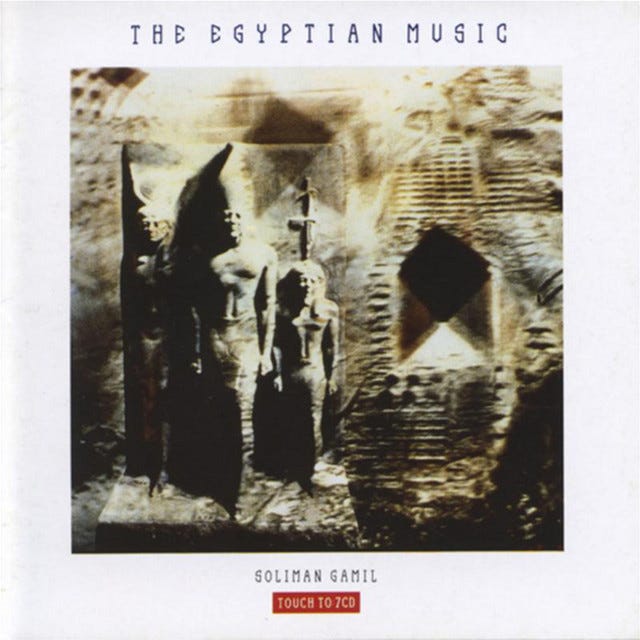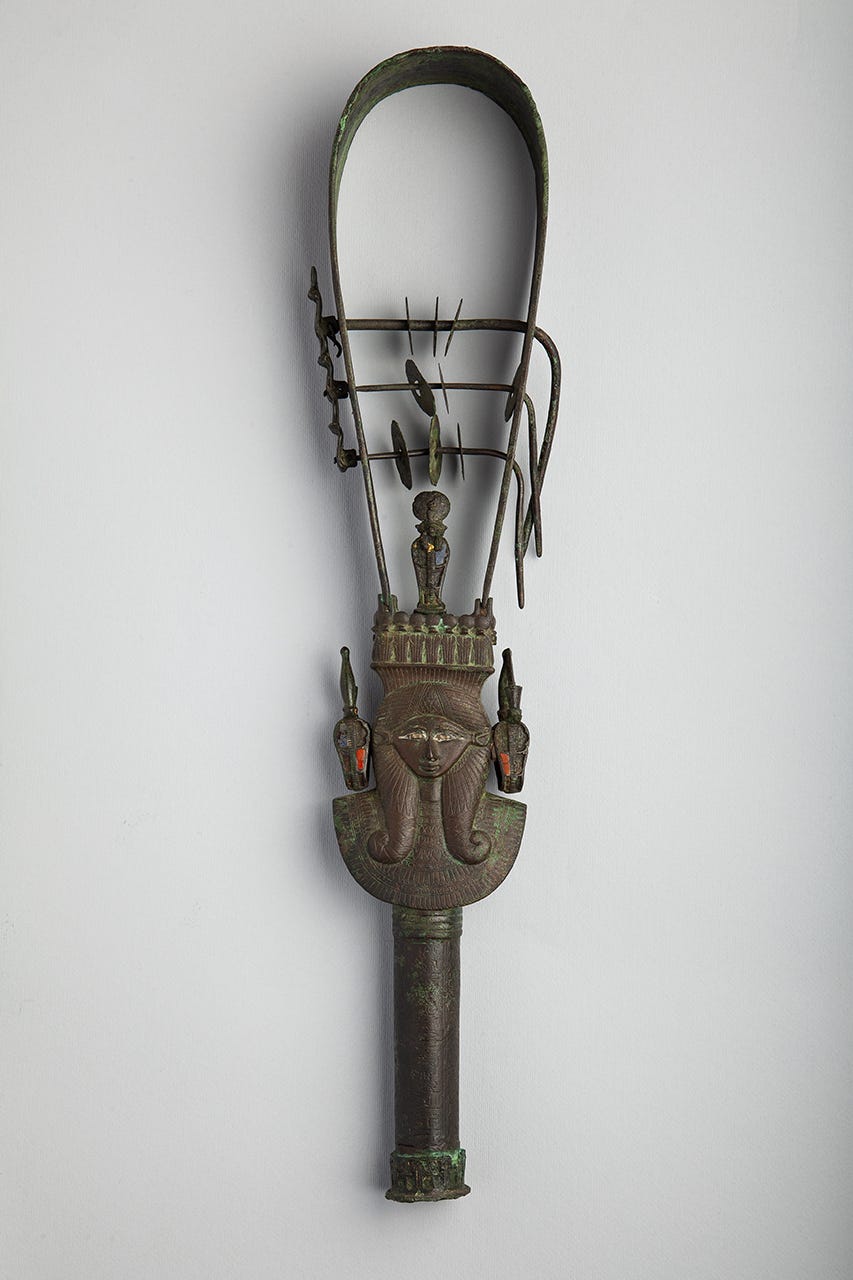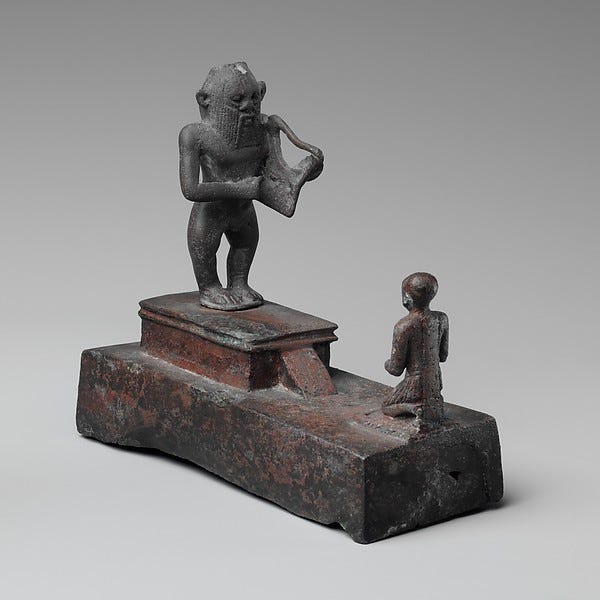EVERY GENRE PROJECT - October 13 - Ancient Egyptian Music
Genre of the Day - Ancient Egyptian Music 𓂀𓁈𓆣𓋹𓀛𓁀𓀾𓀮𓆙
Album of the Day - The Egyptian Music by Soliman Gamil (1987)
I believe one of the best simple pleasures in life is going to an ancient Egyptian museum exhibit. Being dazzled by resplendent gold, intricate hieroglyphic communication, and regal statues communicating the awe-striking civilization’s political, social, and artistic lives. A few years ago, I went to an exhibit that struck me because it displayed textiles and fabrics from ancient Egyptian clothes, miraculously preserved for thousands of years; to see the grandest statements of culture is one thing, but to observe an object that held a different quotidian importance draws you in more intimately to our ancient friends. Music, like fabric, enwraps and situates us directly in what it was like to live among a culture that remains an object of fascination across the world today.
Ancient Egyptian music spans several more centuries than modern western popular conceptions of music; compare three thousand years of civilization to only a couple centuries. Our understanding has been parsed together from scant records compared to other aspects of Egyptian society and to the music of other ancient civilizations, due to the general lack of notation in ancient Egyptian music that makes reconstructions difficult. Hieroglyphs help illuminate a clearer picture of music’s role from military processions to royal ceremony, banquets, and field work. Certain deities who were seen as patrons of the arts were depicted with particular instruments: Ihy and his mother Hathor were both prolific sistrum players, a shaken percussion instrument emulating the sound of a papyrus stalk being shaken, representing the deep interlinkage between nature, the Nile, and cultural rites.
As perhaps one of the most intuitively crafted instruments, harps were also a staple of ancient Egyptian music; the deity Bes, the protector of the domestic sphere, was depicted in statue form using a harp to quell angry spirits. Like the upstream currents blowing over the Nile, wind instruments in the forms of the flute single and double-reed instruments and trumpets aptly befitting royal regalia also formed a part of ancient musical expression. Musicians found employment both in royal ritual at the most sophisticated level and as entertainers at festivals and parties, though individual, casual musicianship was probably less common, which is intriguing given that ancient Egyptians enjoyed hobbies like sports and even board games, but also speaks to the primacy of religion and ritual in music’s place. Some dedicated musicologists have delved into archaeomusicology to try to uncover ancient Egypt’s impact on subsequent musical cultures, given its broad impact on other ancient civilizations in every other capacity; one team intensively studied flutes to discover if the ancient Egyptians played diatonic scales (seven notes) versus pentatonic (five notes). Their findings suggest that their music had advanced to the diatonic scale. Though our knowledge of the sound of ancient Egyptian music is thus surprisingly slim, those who long for Pharaonic times have run with the instrumentation with modern Arab scales to craft music that evokes the civilization.
Soliman Gamil came from a compositional and musical background playing the qanun, a gorgeous but not-so-ancient zither popular around the Middle East and North Africa. Employing modern popular melodies and the qanun while bridging the gap with ritualistic and regal evocations, he harkens back thousands of years on today’s album. He attempts to paint a portrait of both ancient ritual as in the gorgeous qanun work of “The Sinsimia” and every day scenes as in the propulsive pace of the drums on “Collecting the Harvest.” “Melody of Love” imagines romances of antiquity with the eternal elation of sailing horn melodies. The popular memory of ancient Egypt often revolves around tomb explorations and stumbling into a ceremony after a labyrinthine journey; the closest one gets to approximating that is in “The New Nubia,” distant and ornamented flute melodies and a wall of drums carrying thousands of years of historical memory in a musical moment.
More Resources
https://www.metmuseum.org/art/collection/search/546038
https://www.bloomsbury.com/us/dancing-for-hathor-9781847250544/





Listening to the Solimon Gamil album now. Thanks for digging this up! I have no idea whether this is actually what ancient Egyptian music sounded like and I guess there's no way to know. A lot of it is decidedly Arab in flavor, some sounds almost southeast Asian.
Are you familiar with groups like Heilung and Warduna? They have attempted to reconstruct Bronze Age European music using instruments found in archealogical digs, runic texts, and academic reconstructions of proto-Germanic based on modern languages. That is probably a worthy topic for your project!